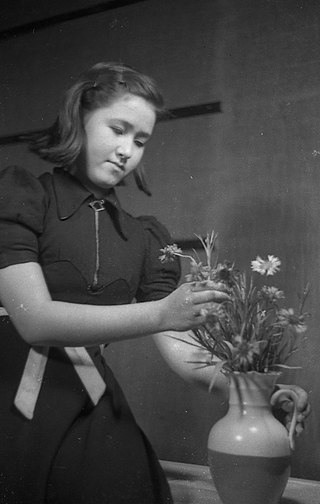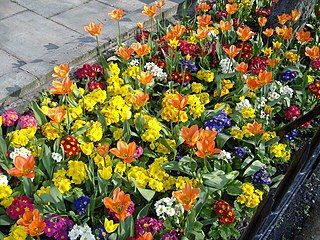
Dianthus caryophyllus, commonly known as carnation or clove pink, is a species of Dianthus native to the Mediterranean region. Its exact natural range is uncertain due to extensive cultivation over the last 2,000 years. Carnations are prized for their vibrant colors, delicate fringed petals, and enchanting fragrance.

Floristry is the production, commerce, and trade in flowers. It encompasses flower care and handling, floral design and arrangement, merchandising, production, display and flower delivery. Wholesale florists sell bulk flowers and related supplies to professionals in the trade. Retail florists offer fresh flowers and related products and services to consumers. The first flower shop in the United States opened prior to 1851.

Floriculture is the study of the efficient production of the plants that produce showy, colorful flowers and foliage for human enjoyment and the human environment. It is a commercially successful branch of horticulture and agriculture found throughout the world. Efficient production practices have been developed over the years, for the hundreds of plant taxa used in the floral industry, increasing the overall knowledge of whole plant biology. Plant breeding and selection have produced tens of thousands of new genotypes for human use. Jasmine, Marigold,Chrysanthemum, Rose, Orchid, Anthurium etc. are flowers of commercial demand.

Floral design or flower arrangement is the art of using plant material and flowers to create an eye-catching and balanced composition or display. Evidence of refined floral design is found as far back as the culture of ancient Egypt. Floral designs, called arrangements, incorporate the five elements and seven principles of floral design.

FTD LLC (FTD), also known as Florists' Transworld Delivery, is a floral wire service, retailer, and wholesaler based in Downers Grove, Illinois, in the United States. FTD was founded as Florists' Telegraph Delivery in 1910, to help customers send flowers remotely on the same day by using florists in the FTD network who are near the intended recipient. It was based in Detroit, Michigan and then moved to Southfield, Michigan prior to its move to Downers Grove. It originated as a retailers' cooperative and began a process of demutualization in 1994. It operates two main businesses: The Consumer Business sells flowers and gift items through its websites and The Floral Business sells computer services, software and even fresh cut flowers to FTD and Interflora affiliated florists.
Flower delivery is a service in floristry. In many cases it is conducted through websites which allow consumers to browse online catalogues of flowers. They are often delivered to a third party, the recipient of the gift. Historically, these were coordinated through telegraphs and later telephones before the advent of the World Wide Web.

Elitch Gardens was a family-owned seasonal amusement park, theater, and botanic garden in the West Highland neighborhood in northwest Denver, Colorado, United States, at 38th and Tennyson streets. For more than a century Elitch's was one of the most popular entertainment destinations in Colorado. It was nationally known for its luscious gardens, the Elitch Theatre, the Trocadero Ballroom, and the premier wooden roller coaster, Mister Twister. The park moved to downtown Denver in 1994 and later in November 1998 became Six Flags Elitch Gardens. The former location has been redeveloped.

The floral industry is focused on the production, distribution and sale of flowers for human enjoyment. The floral industry began in the Golden Century of the Netherlands, where flowers were grown on a large scale on vast estates. The industry continues to diversify from the production of cut flowers to the production and sale of plants and flowers in many different forms. The global floral industry market size is estimated to be worth US$ 50040 million in 2022 and is forecast to increase to US$ 58030 million by 2028 with a compound annual growth rate of 2.5% during the review period.

The White House chief floral designer is responsible for the planning, design, arrangement, and placement of all floral decorations for the first family, their private entertaining, and official state functions at the White House, the official residence and principal workplace of the president of the United States. The current chief floral designer is Hedieh Ghaffarian.
Villa Guerrero is a municipality in the State of Mexico, Mexico. The municipal seat is the town of Villa Guerrero. It is located on the southern slopes of the Nevado de Toluca, also known as Xinantecatl, and is 50 minutes/58 km from Toluca.

The Boston Flower Exchange is a wholesale flower market located in Boston, Massachusetts. Founded as a marketplace that local growers could rent cooperatively to sell their products in a space more suited to their needs than Boston's historic Haymarket open-air marketplace, it has been the focal point of the floral trade of New England for over a hundred years. Although originally a local growers' wholesale market, the Flower Exchange now features flowers and foliage from dozens of countries and has expanded to carry potted plants, glassware, pottery and other floral supplies. The Flower Exchange is not open to the public and is limited to members of the trade only.
The Flower District of Downtown Los Angeles is a six block floral marketplace, consisting of nearly 200 wholesale flower dealers, located within the LA Fashion District. What started almost 100 years ago as a small flower mart near Santa Monica, California, has grown into the United States' largest wholesale flower district in its current downtown location. The Market is open very early in the morning, Monday - Saturday, and closes in the early afternoon. Every commercially available cut flower can be purchased there.

Many types of flowering plants are available to plant in flower gardens or flower beds. The floral industry calls these plants, bedding plants. These fast-growing plants in seasonal flower beds create colourful displays, during spring, summer, fall or winter, depending on the climate. Plants used for bedding are generally annuals, but biennials, tender perennials, and succulents are used.

The Texas State Florists' Association (TSFA) was founded in 1914 and is headquartered in Austin, Texas. Since its inception, the TSFA has grown into a professional trade association that covers many branches of the floral industry. Its membership base includes a diverse assortment of people in the floral industry, and it is involved in professional services and marketing in support of floral interests, state legislation, and the provision of educational opportunities. It represents the Texas floral industry, and has members in ten additional states. The organization hosts an annual convention, the first of which occurred in 1914. The TSFA sponsors the Texas Certified Florists Program, and publishes a monthly magazine named TEXAS in Bloom.

Cut flowers are flowers and flower buds that have been cut from the plant bearing it. It is removed from the plant for decorative use. Cut greens are leaves with or without stems added to the cut flowers for contrast and design purposes. These displays improve the quality of the human environment.
The Society of American Florists (SAF) is a national US Trade Association representing floristry in the United States (US). Retailers, growers, wholesalers, importers, manufacturers, suppliers, educators, students and allied organizations are members.
Winston Flowers is a third-generation, family-owned and -operated floral retailer. Based in Boston, Massachusetts, the company has four Massachusetts retail shops—Boston, Massachusetts; Chestnut Hill, Massachusetts; and Wellesley, Massachusetts—and one in Greenwich, Connecticut. The company's design studios in Boston's South End and Long Island City, New York offer daily delivery to Greater Boston, New York City, Fairfield County, and Westchester County, with the capacity to fulfill orders across the continental US through a network of partners.
Edward Gurney Hill (1847–1933) was a nurseryman and rose breeder from Richmond, Indiana. He and his father, Joseph, established the Hill and Company nursery business in 1881. Hill later joined with his son, Joseph Herbert, to hybridize roses and produced many successful and popular rose varieties.
Thomas Davey was a British florist and nurseryman based in Camberwell, Surrey, and later in Chelsea, Middlesex, both now in London, England. The son of a nurseryman of the same name, he was known for his "florists' flowers", the type of flowers traditionally popular with English florists, and specialised in tulips, geraniums, and pinks. He capitalised on a new enthusiasm for tulips and flower-growing at the start of the 19th century in what has been described as a "cult of florists' flowers", giving exhibitions that attracted large crowds and publishing sales catalogues, one of which offered nearly 800 different types of tulip bulbs.












